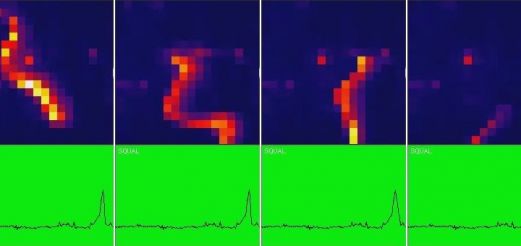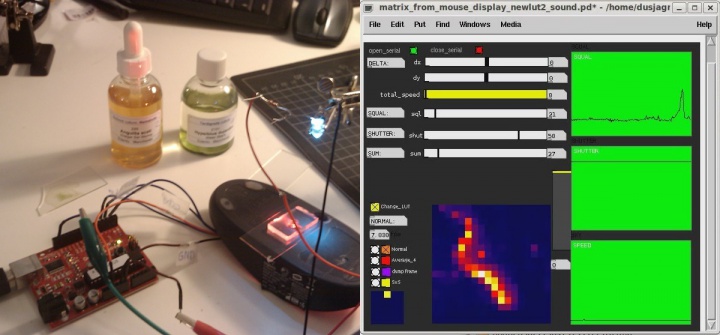Marc Dusseiller: Hackability of abundant consumer electronics for low-cost diagnostics
aka optical mouse hacks aka How to hack a mouse to see a worm in low-res retro c64 pixel staaaayyle
Date: Wednesday, November 9th at 8pm
Early experiments by dusjagr
Notes, 17 May 2010, late at night:
"Just done further experiments with the hacked optical mouse sensor, in this case a Avago ADNS2610, from a cheap wired logitec optical mouse. So i managed to connect the optical sensor to the arduino and send all the data, including the image from the 18×18pixel sensor, through a serial connection to puredata (pd). The sensor is a real high-end device, it calculates the optical flow, thus gets out motion and the speed of the mouse, it detects focus by a SQL-value, which is proportional to the number of features the sensor detects on a surface. and other values such as maximum and average pixel and shutter speed can be read from the registers.hmm what happens if i put some microorganisms on it... ah just found an old bottle of nematodes :-)"
Technical description:
The sensor of a standard optical mouse is a high-end embedded image processor (eg. Avago2610, 2$), analyzing the optical flow of an image recorded by a 18x18 CMOS sensor . It is optimized for high-speed and reliability, is mass produced and available abundantly worldwide.
Hacking into the chip directly allows to get more information about the detected image, such as surface quality (SQUAL), intensity and shutter speed. Serial communication to the sensor-chip is straight forward and can be done using an open-hardware microcontroller platform, such as the Arduino. We have already tested the SQUAL value to be used for the detection of microparticles and whole microorganisms. We now want to test the system for quantitative image analysis, microarray read-out and counting of microorganisms, particles and cells.
The most simple setup consists of the hacked optical mouse, inverted for easier usage and addition of extra lighting. The sensor-chip of the mouse is connected to the open-hardware platform Arduino, which communicates through USB2serial with the open-source software PureDate (PD) for data visualization and analysis. Right: Through a substantial change in the SQUAL value motion and proximity detection of single microorganisms has been shown with nematodes and single cell organisms.
The project was developed with the help of Urs Gaudenz and Budi Prakosa aka VJ Manticore.
 Dr. Marc R. Dusseiller (1975) (Zürich, Schweiz) is a transdisciplinary scholar, lecturer for micro- and nanotechnology, cultural facilitator and artist. He works in an integral way to combine science, art and education. He performs DIY-workshops in lo-fi electronics, music and robotics, has made various short movies and is now developing means to perform biological science (Hackteria | Open Source Biological Art) in a DIY fashion in your kitchen or your atelier. He is also co-organizing Dock18, Room for Mediacultures, and various other engagments like the diy* festival, national and international workshops for both artists and schools and children as the president of the Swiss Mechatronic Art Society, SGMK and is currently co-curating KIBLIX 2011, "Share is in the Air", with a strong focus on DIWO, collaboration, alternative educational models in Art/Tech and "Workshopology
Dr. Marc R. Dusseiller (1975) (Zürich, Schweiz) is a transdisciplinary scholar, lecturer for micro- and nanotechnology, cultural facilitator and artist. He works in an integral way to combine science, art and education. He performs DIY-workshops in lo-fi electronics, music and robotics, has made various short movies and is now developing means to perform biological science (Hackteria | Open Source Biological Art) in a DIY fashion in your kitchen or your atelier. He is also co-organizing Dock18, Room for Mediacultures, and various other engagments like the diy* festival, national and international workshops for both artists and schools and children as the president of the Swiss Mechatronic Art Society, SGMK and is currently co-curating KIBLIX 2011, "Share is in the Air", with a strong focus on DIWO, collaboration, alternative educational models in Art/Tech and "Workshopology
Ljudmila program at KUD France Preseren Trnovo and the Ljudmila Society, laboratory for science and arts, are both supported by the Slovene Ministry of Culture and MOL - Department of Culture.

